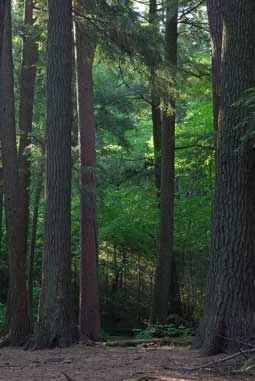Cathedral Pines
No. 496

Photo by Thomas A. Meyer/DNR
Cathedral Pines features one of the finest old-growth pine-hemlock stands on the Chequamegon-Nicolet National Forest. The majority of this large site consists of upland mesic forest on sandy loam soils with stands generally composed of combinations of sugar maple, yellow birch, hemlock, white ash, basswood and beech. Paper birch is also a common associate, forming almost pure stands in places. Hardwoods only occasionally exceed pole and small sawlog size. Hemlock is sometimes scarce or lacking. The shrub layer is poorly developed, consisting of red elder and maple-leaved viburnum.
Common ground layer species include intermediate wood fern, club mosses, partridgeberry, beech drops, sedges, and tree seedlings. The highlights of the natural area are the stands of old-growth conifers dominated by hemlock, along with super-canopy red and white pines. They're found in the area of the Cathedral Pines hiking trail, the west-central part of the complex, the uplands bordering McCaslin Brook, and near Archibald Lake. A few rather dry areas along Archibald Lake have younger stands of red pine, sometimes with thickets of hemlock, balsam fir, and hazel beneath.
A large colony of reproducing Canada yew also occurs along the lake. Several wet-mesic forest types occur in the McCaslin Brook floodplain, including red maple-black ash-elm, hemlock-white cedar, and mixed hardwoods dominated by yellow birch. Most stands are quite small due to the narrowness of the floodplain and the varying hydrological conditions. The largest white cedars in the complex are found along the creek, often extending up the steep slopes where they become mixed with hemlock and white pine. In places, ephemeral ponds and small open areas form interesting habitats for rare plants, including sweet colt's-foot and woodland horsetail.
Numerous small kettle ponds and bogs are located in the pitted area just north of Archibald Lake. These are usually bordered by sedges and grasses and some are nearly filled with cattails and other emergent aquatics, providing good waterfowl habitat. In general, the forests here have had a relatively light management history and the present species mix appears to be similar to that of presettlement times. An active Great Blue Heron rookery is found in the red and white pines traversed by the hiking trail. Visitors should be very careful not to disturb the birds and rookery in the spring, as too much disturbance may force the herons to abandon their nests and relocate the rookery. Cathedral Pines is owned by the US Forest Service and was designated a State Natural Area in 2007.
Very few State Natural Areas have public facilities, but nearly all are open for a variety of recreational activities as indicated below. Generally, there are no picnic areas, restrooms, or other developments. Parking lots or designated parking areas are noted on individual SNA pages and maps. If a developed trail is present, it will normally be noted on the SNA map and/or under the Maps tab. A compass and topographic map or a GPS unit are useful tools for exploring larger, isolated SNAs.
The good majority of SNAs are isolated and have few or no facilities. Some SNAs have vehicle access lanes or parking lots, but their accessibility may vary depending on weather conditions. Parking lots and lanes are not plowed during winter. Hiking trails may be nonexistent or consist of undeveloped footpaths. A GPS unit or compass and a detailed topographic map are useful tools for exploring larger SNAs.
Non-DNR lands
Entrance fees: For non-DNR-owned SNAs, we are unaware of any vehicle or admission fees. However, please contact the landowner for more information.
Hunting and trapping
Other activities
Other allowable activities such as - but not limited to camping, geocaching and bicycling are determined by the landowner. Please contact them directly or visit their websites for details.
Location
Within the Chequamegon-Nicolet National Forest. Oconto County. T32N-R15E, Sections 1, 2. T33N-R15E, Sections 25, 26, 35, 36. 1,874 acres.
Driving directions
To reach the Cathedral Pines hiking trail, which loops through a block of old-growth conifer forest: from the junction of State Highway 32 and County Highway F in Lakewood, go north on 32 1.0 mile to Archibald Lake Road (FR 2121); then south 1.5 miles to Cathedral Drive (FR 3299); then northwest 0.4 miles to the Cathedral Pines parking area. To explore the northeast section of the natural area: from the junction of highways 32 and F in Lakewood, go north on 32 for about 2.0 miles; STH 32 forms the northeast boundary of the site for about 1.3 miles. County Highway T and Presbyterian Road provide access to the west side of the site: from Townsend, travel south on Highway T for about one mile.
The DNR's state natural areas program is comprised of lands owned by the state, private conservation organizations, municipalities, other governmental agencies, educational institutions and private individuals. While the majority of SNAs are open to the public, access may vary according to individual ownership policies. Public use restrictions may apply due to public safety, or to protect endangered or threatened species or unique natural features. Lands may be temporarily closed due to specific management activities.
Users are encouraged to contact the landowner for more specific details. The data shown on these maps have been obtained from various sources, and are of varying age, reliability, and resolution. The data may contain errors or omissions and should not be interpreted as a legal representation of legal ownership boundaries. To create your custom map where you can zoom to a specific location, please use the DNR's Mapping Application.
Cathedral Pines is owned by: US Forest Service
